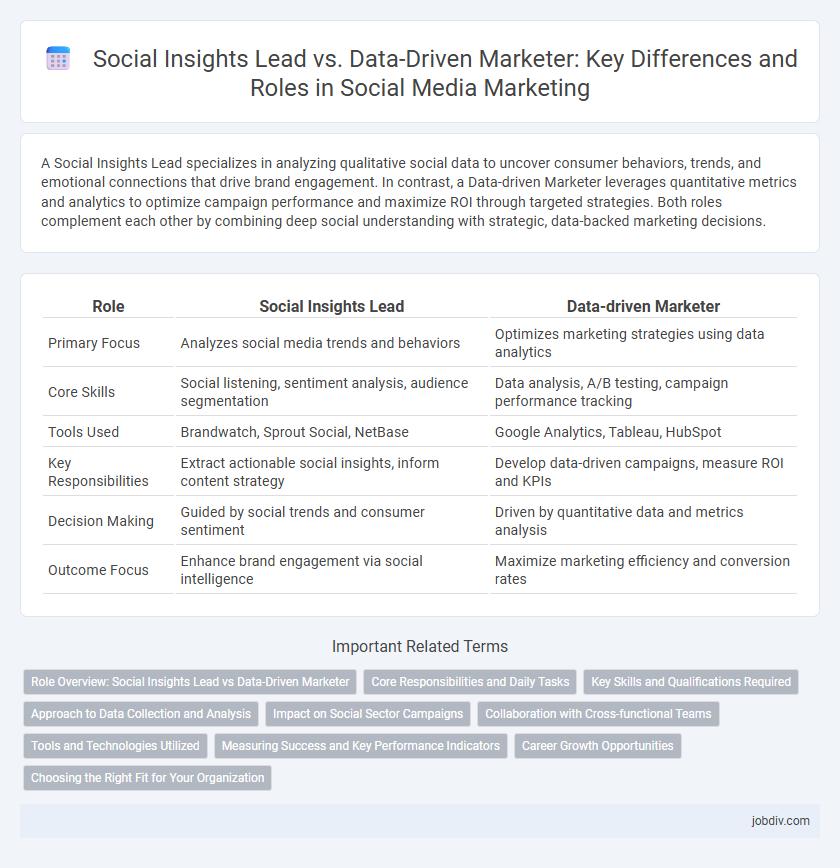A Social Insights Lead specializes in analyzing qualitative social data to uncover consumer behaviors, trends, and emotional connections that drive brand engagement. In contrast, a Data-driven Marketer leverages quantitative metrics and analytics to optimize campaign performance and maximize ROI through targeted strategies. Both roles complement each other by combining deep social understanding with strategic, data-backed marketing decisions.
Table of Comparison
| Role | Social Insights Lead | Data-driven Marketer |
|---|---|---|
| Primary Focus | Analyzes social media trends and behaviors | Optimizes marketing strategies using data analytics |
| Core Skills | Social listening, sentiment analysis, audience segmentation | Data analysis, A/B testing, campaign performance tracking |
| Tools Used | Brandwatch, Sprout Social, NetBase | Google Analytics, Tableau, HubSpot |
| Key Responsibilities | Extract actionable social insights, inform content strategy | Develop data-driven campaigns, measure ROI and KPIs |
| Decision Making | Guided by social trends and consumer sentiment | Driven by quantitative data and metrics analysis |
| Outcome Focus | Enhance brand engagement via social intelligence | Maximize marketing efficiency and conversion rates |
Role Overview: Social Insights Lead vs Data-Driven Marketer
The Social Insights Lead specializes in interpreting social media trends and audience behavior to inform strategic decisions, leveraging qualitative and quantitative data from various social platforms. The Data-Driven Marketer prioritizes analytics and performance metrics to optimize marketing campaigns, focusing on customer segmentation, ROI analysis, and A/B testing. Both roles require expertise in data analysis but differ in scope: the Social Insights Lead emphasizes consumer sentiment and engagement patterns, while the Data-Driven Marketer concentrates on actionable metrics to drive marketing efficiency.
Core Responsibilities and Daily Tasks
A Social Insights Lead focuses on analyzing social media trends, interpreting consumer behavior, and generating actionable insights to guide brand strategy and content creation. A Data-driven Marketer prioritizes leveraging data analytics, campaign performance metrics, and customer segmentation to optimize marketing strategies and drive ROI. Both roles require proficiency in data analysis and storytelling but diverge in emphasis on social listening versus broader marketing analytics.
Key Skills and Qualifications Required
Social Insights Leads require expertise in qualitative and quantitative research methods, strong analytical skills, and the ability to translate consumer behavior into actionable business strategies. Data-driven Marketers excel in data analysis, statistical modeling, and proficiency with digital marketing tools, leveraging metrics to optimize campaign performance and ROI. Both roles demand strong communication skills and a deep understanding of social media platforms, but Social Insights Leads emphasize strategic foresight while Data-driven Marketers focus on execution and measurement.
Approach to Data Collection and Analysis
A Social Insights Lead employs qualitative methods such as sentiment analysis, focus groups, and social listening tools to capture nuanced consumer behavior and emerging trends. In contrast, a Data-driven Marketer relies heavily on quantitative data, utilizing metrics like click-through rates, conversion rates, and A/B testing to optimize campaign performance. Both roles integrate advanced analytics platforms, but the Social Insights Lead emphasizes contextual interpretation while the Data-driven Marketer prioritizes statistical significance and predictive modeling.
Impact on Social Sector Campaigns
A Social Insights Lead leverages qualitative and quantitative data to uncover behavioral trends and audience sentiment, enabling deeper emotional connections in social sector campaigns. In contrast, a Data-driven Marketer focuses on optimizing campaign performance through metrics such as engagement rates, conversion tracking, and ROI analysis, ensuring efficient resource allocation. Combining both roles enhances campaign effectiveness by aligning strategic insights with data-backed execution, maximizing social impact and stakeholder engagement.
Collaboration with Cross-functional Teams
A Social Insights Lead leverages qualitative and quantitative social data to guide marketing strategies, working closely with cross-functional teams including product development, customer service, and sales to ensure cohesive brand messaging. A Data-driven Marketer focuses heavily on analytics and metrics to optimize campaign performance, collaborating with IT, analytics, and creative teams to implement data-backed marketing initiatives. Both roles require strong communication and alignment skills to translate social insights and data into actionable strategies that drive business growth.
Tools and Technologies Utilized
Social Insights Leads leverage advanced social listening platforms like Brandwatch and Talkwalker to analyze consumer sentiment and emerging trends, while Data-driven Marketers prioritize marketing automation tools such as HubSpot and Marketo to optimize campaign performance through predictive analytics. Both roles utilize data visualization software like Tableau or Power BI to translate complex datasets into actionable strategies, but their toolsets differ in emphasis--Social Insights Leads focus on qualitative social data extraction whereas Data-driven Marketers emphasize quantitative customer segmentation and ROI tracking. Integrating AI-driven tools such as IBM Watson and Google Analytics further enhances their capabilities by enabling real-time analytics and personalized marketing approaches.
Measuring Success and Key Performance Indicators
Measuring success for a Social Insights Lead centers on extracting actionable insights from qualitative social data, emphasizing brand sentiment and consumer behavior trends. Key Performance Indicators (KPIs) for this role include engagement rate, sentiment analysis accuracy, and social listening metrics that reveal deeper audience understanding. In contrast, a Data-driven Marketer prioritizes quantitative metrics like conversion rates, return on ad spend (ROAS), and customer acquisition costs to optimize marketing campaigns based on data analytics.
Career Growth Opportunities
Social Insights Leads leverage advanced analytics and consumer behavior expertise to drive strategic decisions, positioning themselves for leadership roles within marketing and product teams. Data-driven Marketers utilize performance metrics and campaign data to optimize marketing strategies, often progressing toward senior marketing management and specialized analytics roles. Both career paths offer growth by enhancing data literacy, strategic thinking, and cross-functional collaboration skills in the evolving digital marketing landscape.
Choosing the Right Fit for Your Organization
A Social Insights Lead excels in interpreting consumer behavior and social trends to craft strategic narratives, driving engagement through qualitative analysis and creative storytelling. A Data-driven Marketer leverages extensive quantitative data, analytics, and performance metrics to optimize campaigns and maximize ROI with precision targeting. Selecting the right fit depends on your organization's priority: narrative-driven brand building or performance-focused marketing grounded in data analytics.
Social Insights Lead vs Data-driven Marketer Infographic

 jobdiv.com
jobdiv.com